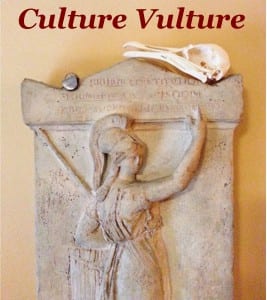Introducing Culture Vulture… Doctors, Dissection and Resurrection Men: A review
By Jack Ashby, on 8 March 2013

Culture Vulture: A vulture skull in UCL Art Museum
We’ve been doing a few exhibition reviews on the blog lately, and after the unprecedented success of the new Book Worm series (launched yesterday) we thought to ourselves “what weak animal based cliched pun can we deliver for a new exhibitions review feature?”. I think you’ll agree that “Culture Vulture” was the only option.
I went along to Doctors, Dissection and Resurrection Men. The exhibition is the outcome of an excavation by museum archaeologists of a burial ground at the Royal London Hospital in 2006, which uncovered remains that had clearly been used in anatomical dissection. My interest was obvious – last year at the Grant Museum we put on Buried on Campus – an exhibition about the discovery and research into c7000 human remains unexpectedly discovered buried at UCL in 2010, also found to be have been used anatomically. I wanted to see how a museum with a budget tackled the same subject.
The answer is: exceptionally well. One room covers the specifics of the excavated material itself – what they could learn from the skeletons and what they were used for, as well as the story of the Royal London Hospital site. The real meat of the exhibition, though, was the story of the procurement of human material by surgeons and students in England.
They set the scene very clearly and evocatively. Medics of the time needed human material on which to train, but the only official channel was bodies from the gallows. Grave-robbing was a big market, and then came the trend of “Burking” – cutting out the middle-man at the graveyard and murdering those who wont be missed to sell their corpses to unscrupulous doctors.
This story is told through contemporaneous – but entertaining – satirical art and poems (read by either Ray Winstone or someone trying very hard to sound like him), specific stories of missing persons, and objects. The mix works really well and was covered to exactly the right level to keep me interested but not asking more questions.
The 1832 Anatomy Act largely ended all that. Dead bodies not claimed at hospitals were to be used for medical training. The story here is that at the time it was mostly the poor who died in hospitals (dying at home was more bourgeois), and the poor were also less likely to be “claimed”. This meant that the burden of providing bodies fell on one portion of society. Again the Museum of London strikes a great balance between narrative and objects.
The end of the exhibition looks to practice today. Working where I do means that I am reasonably au fait with the 2004 Human Tissues Act, which controls the use of human material today, which came about largely after the Alder Hey controversy. What I didn’t know was that this was the first piece of relevant legislation since the 1832 Act.
The real triumph of the exhibition, for me, was how they subtly elicited personal reflection into feelings about the use of one’s own body after death. It happened throughout the historical exploration, seemingly without crass interpretive prompting. At the very end is a video piece with snippets of interviews from people today, discussing their thoughts on organ and body donation. Again it avoids the obvious and mistaken traps of asking visitors “What do you think about this” in so many words, but rather teases out internal musings in a much more impactful way. It is a demonstration of how museums can have real meaning in society – something the sector is, and should be, falling over itself to deliver.
Museums are generally social spaces. However, if you really are up for some proper engagement with your inner thoughts, I’d consider visiting this exhibition on your own.
One Response to “Introducing Culture Vulture… Doctors, Dissection and Resurrection Men: A review”
- 1
 Close
Close


[…] is the second of our Culture Vulture exhibition reviews (the first is here) As I mentioned in an earlier article about whether a degree in museum studies was worth it […]